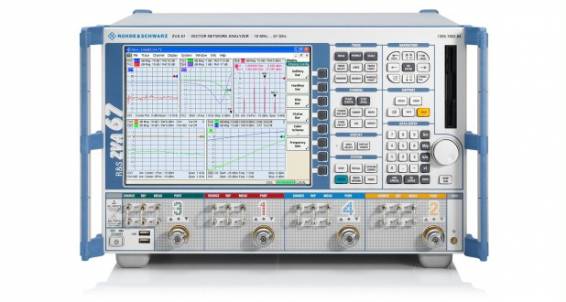Key Facts
- Linear and nonlinear amplifier and mixer measurements
- Noise figure measurements
- Pulse profile measurements with 12.5 ns resolution
- True differential measurements for reliable characterization of active devices with balanced ports
- High output power typ. > 18 dBm
- Wide dynamic range typ. > 140 dB
- High measurement speed < 3.5 μs per test point
- Wide IF bandwidth: 1/5/30 MHz
- Versatile calibration techniques: TOSM, TRL/LRL, TOM, TRM, TNA, UOSM
- Automatic calibration units
- Phase and group delay measurements on mixers with and without LO access
- Frequency range: 300 kHz to 8 GHz (R&S®ZVA8), 10 MHz to 24/40/50/67/110 GHz (R&S®ZVA24/40/50/67/110)
Features & Benefits
- High measurement throughput
- Short measurement times due to fast synthesizers, wide IF bandwidths and high dynamic range
- Ergonomic user interface
- More than 100 traces and channels
- Measurement wizard for easy setup of multiport and balanced measurements
- Easy and error-free calibration
- Versatile calibration techniques for test fixtures as well as for coaxial and on-wafer applications
- Automatic calibration with calibration unit
- Quick and reliable measurements on mulitiports and balanced components
- Virtual and true differential mode for linear and nonlinear testing of differential components
- Linear and nonlinear amplifier and mixer measurements
- Simultaneous measurement of noise figure and S-parameters
- Wide power sweep range for small and large signal analysis in one sweep
- Second internal source for fast hot S22, IMD and mixer measurements
- Phase and group delay measurements of the conversion loss on mixers and converters with and without LO access
- Conversion loss measurement of converters with up to three conversion stages
- Intermodulation measurements on mixers
- Options to enhance flexibility, power and dynamic range
- Direct access to the generators and receivers for 30 dBm output power and 150 dB dynamic range
- Time domain with linear prediction for increased resolution
- Convenient handling of pulse profile measurements
- Easy setup of pulse profile measurements with 12.5 ns time resolution and up to 30 MHz measurement bandwidth
- Measurements on active devices made easy
- Extension unit for the R&S®ZVA with integrated combiner, pulse modulators and harmonic filters












